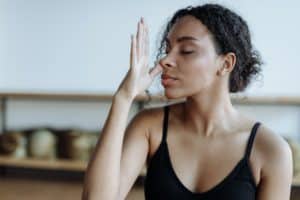Calming Cortisol Levels with the Breathing

The hormone cortisol helps us rise in the morning. And, it’s critical to save our lives if we are in danger. However, in our modern-day lives, anxiety, and stress leads to too much cortisol. When chronic stress boosts cortisol levels too high, too often it can cause chronic inflammation, which leads to a long list of health problems, including anxiety, memory and cognitive decline, weight gain, heart disease, and metabolic disorders.
Cortisol is that hormone tied to our fight or flight response. You’ve most likely heard of how our bodies respond to constant stress as if we are being chased by a hungry prehistoric animal. Today threats are more insidious but no less dangerous to our health and longevity than the predators who lived billions of years ago. “I think COVID brought out a lot of anxiety that may have been under the surface, it peeked through and just kept going for a lot of people,” said Sunny Raleigh, DO in a sleep podcast interview, I Thought This Was Over, with Kimber Del Valle, PsyD. Dr. Raleigh says our brains need to be reminded that even though our cortisol levels tell us we are in danger, “we are no longer being chased by that saber-toothed Tiger.”

So how do we protect our brains from the modern-day chase and down-regulate cortisol? You’ve no doubt heard that yoga and meditation calm both mind and body. But have you heard of alternative nostril breathing? Dr. Raleigh swears by it.
It’s a yogic breath control practice that translates in Sanskrit to an “energy cleansing channel” (nadi shodhana pranayama). This form of breathing not only relaxes the body and mind and reduces anxiety and stress, but studies also support it to reduce the risk factors of cardiovascular disease including high blood pressure.
What we know about deep breathing is that it replenishes air in all parts of the lung, as compared to shallow breathing, which only replenishes air at the base of the lungs. This process dampens the effect of stress and strain on the body. Dr. Raleigh explains that deep inhalation as is done in alternative nostril breathing, shifts the balance of the limbic system toward the parasympathetic system, which is responsible for our “rest and digest” system.
The limbic system produces hormones that are responsible for our feelings of reward, learning, memory, hunger and thirst, as well as the infamous fight or flight response. Deep breathing restores the body back to where it belongs after an emergency response or long-term chronic stress response, via the parasympathetic system.
How to do alternate nostril breathing
There are three phases of alternate nostril breathing: Purak (inhalation), Kumbhaka (retention), and Rechak (exhalation). The technique may seem a little strange at first, but the benefits are worth giving it a try.
The practice of nostril breathing is based on pranayama, one of the eight limbs of Asthanga Yoga, which includes a variety of respiratory techniques. For sleep and stress reduction, we recommend the technique called Anulom-Vilom, or alternate-nostril breathing (ANB). It used left nostril inhalation followed by right nostril exhalation and then right nostril inhalation followed by left nostril exhalation.
Why this? Several studies explored the long-term effects of this technique on both the cardiovascular and autonomic nervous systems in both healthy people and those with blood pressure issues. The after the practice of ANB was done for three months, it slowed the basal heart, reduced blood pressure and improved the way the body responded to stressors (called autonomic reactivity).
The best way to explain is to show you how it is done. We chose Yoga with Adriene, but any YouTube search will land you good results. “It is a great way to calm the nervous system and relieve tension and anxiety. It is great for concentration, cleansing and is a fantastic headache cure,” says Adriene Mishler. Dr. Raleigh agrees and often guides her patients toward this type of deep breathing.
For more tips from Dr. Raleigh on how to reduce stress and get a better night’s sleep, don’t miss her podcast interview with Kimber Del Valle, PsyD, host of the podcast series, I Thought This Was Over.
Sources:
Ghiya S, Lee CM. Influence of alternate nostril breathing on heart rate variability in non-practitioners of yogic breathing. Int J Yoga. 2012;5(1):66-69. doi:10.4103/0973-6131.91717
Turankar AV, Jain S, Patel SB, et al. Effects of slow breathing exercise on cardiovascular functions, pulmonary functions & galvanic skin resistance in healthy human volunteers – a pilot study. Indian J Med Res. 2013;137(5):916-921.

